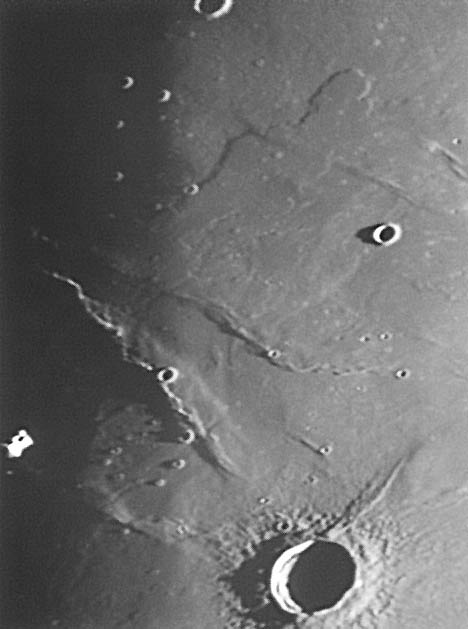Difference between revisions of "April 23, 2005"
| (2 intermediate revisions by the same user not shown) | |||
| Line 1: | Line 1: | ||
__NOTOC__ | __NOTOC__ | ||
=The Best Lava Flow on the Moon= | =The Best Lava Flow on the Moon= | ||
| + | <!-- Start of content --> | ||
<table width="85%" border="0" align="center" cellpadding="6" cellspacing="2"> | <table width="85%" border="0" align="center" cellpadding="6" cellspacing="2"> | ||
<tr> | <tr> | ||
| Line 25: | Line 26: | ||
April 18, 2005. 10" f/6 Newtonian + 5X barlow + Philips Toucam Pro. Seeing was 6/10.</p> | April 18, 2005. 10" f/6 Newtonian + 5X barlow + Philips Toucam Pro. Seeing was 6/10.</p> | ||
<p><b>Related Links:</b><br> | <p><b>Related Links:</b><br> | ||
| − | [ | + | [http://www.lpi.usra.edu/expmoon/Apollo15/A15metric1555.gif Apollo 15 View ] |
<br>Rukl Plates 10, 20 | <br>Rukl Plates 10, 20 | ||
</p> | </p> | ||
| Line 40: | Line 41: | ||
<p align="center" class="main_titles"><b>Author & Editor:</b><br> | <p align="center" class="main_titles"><b>Author & Editor:</b><br> | ||
[mailto:tychocrater@yahoo.com Charles A. Wood]</p> | [mailto:tychocrater@yahoo.com Charles A. Wood]</p> | ||
| − | < | + | <!-- Cleanup of credits --> |
| − | + | <!-- Cleanup of credits --> | |
| − | < | + | <!-- Cleanup of credits --> |
| − | + | <!-- Cleanup of credits --> | |
| − | + | <!-- Cleanup of credits --> | |
| − | < | + | <!-- Cleanup of credits --> |
| − | < | + | <!-- Cleanup of credits --> |
| − | + | <!-- Cleanup of credits --> | |
| − | < | + | <!-- Cleanup of credits --> |
| − | + | <!-- Cleanup of credits --> | |
</td></tr> | </td></tr> | ||
</table> | </table> | ||
<p> </p> | <p> </p> | ||
| + | <!-- End of content --> | ||
{{wiki/ArticleFooter}} | {{wiki/ArticleFooter}} | ||
Latest revision as of 14:14, 15 March 2015
The Best Lava Flow on the Moon
Image Credit: K.C. Pau |
|
The Best Lava Flow on the Moon Mare basins are filled by a vast number of individual lava flows that erupted from many vents. Because the flows are thin - estimates are typically 10 to 30 m - their edges were relatively quickly eroded away by subsequent small impacts, and few individual flows are now recognizable. The absolute best preserved lava flow on the Moon erupted from vents near the crater Euler and traveled nearly 600 km toward the center of Mare Imbrium. This flow was fantastically shown on Apollo 15 images, but has always been very difficult to image from earth. Until last year when KC Pau, the amazing amateur who images the Moon from his skyscraper balcony in Hong Kong took the best ever Earth-based image of a lunar lava flow - that image was LPOD for July 19, 2004. Now KC has improved significantly on that triumph with todays LPOD. The lower sun angle and larger image scale better define the margins of the flow. The July LPOD labels all the features, but the crater Lambert is at the bottom of the image and the Zirkel Ridge crosses diagonally to the NW from the crater. In the previous LPOD I suggested that the Zirkel Ridge must have formed after the lava flow which probably could not have climbed over the ridge. KCs new image shows that part of the lava flow is apparently stopped by and dammed behind the unnamed ridge between McDonald and Carlini. This suggests that this smaller ridge did exist before the eruption. If so the tectonic deformation of Imbrium was still occurring about 2.5 b.y. ago when the flow is estimated to have been erupted. Each image adds to our understanding! Technical Details: Related Links: Yesterday's LPOD: Resource for All!! Tomorrow's LPOD: Fabulous Fab! |
|
Author & Editor: |
COMMENTS?
Register, Log in, and join in the comments.




